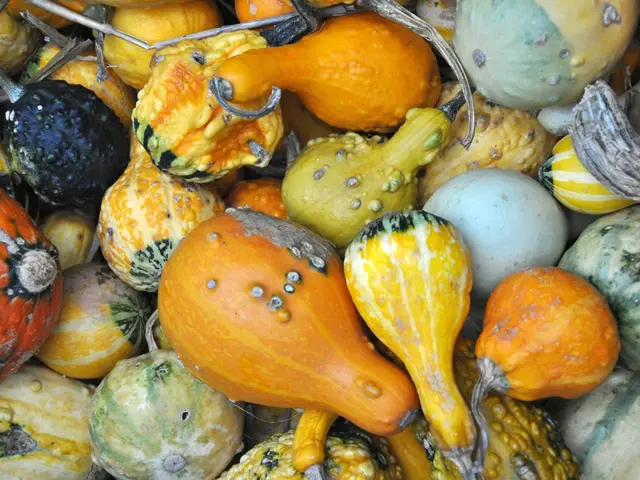Spice Profiles and Functions from India: A Comprehensive Overview
Indian cuisine is renowned for its rich flavours, aromas, and vibrant colours, all of which can be attributed to the extensive use of a variety of spices. These spices not only enhance the taste of dishes but also carry numerous health-promoting properties.
One such spice is cumin, also known as jeera. Cumin aids digestion, reduces bloating, supports fat loss, lowers blood sugar and cholesterol, detoxifies the liver, and boosts immunity. It is rich in iron and antioxidants and is used whole or ground in curries, dals, rice dishes, and spice blends like garam masala.
Turmeric, or haldi, is another essential Indian spice, known for its anti-inflammatory and antioxidant properties. It adds yellow colour and an earthy flavour to curries, soups, and vegetable dishes.
Asafoetida, or hing, promotes digestion, reduces gas and bloating, and has antimicrobial properties. It is often used in small quantities, fried in oil to flavour dals, vegetable dishes, and pickles.
Fennel seeds are used to improve digestion, relieve bloating and gas, and help balance hormones. They are added to spice mixes, sweets, and used for digestive tea or post-meal mouth freshener.
Coriander seeds aid digestion, control blood sugar, have anti-inflammatory properties, and support gut health. They are ground or whole in curries, soups, sauces, and spice blends.
Cloves, or laung, have antimicrobial properties, improve digestion, add flavour and aroma, and have antiseptic qualities. They are used in rice dishes, chai (tea), garam masala, and festive recipes.
Cardamom, or elaichi, is an antioxidant, aids digestion, freshens breath, and supports respiratory health. It is flavoured in sweets, chai, rice dishes, and rich gravies.
Black pepper, or kali mirch, boosts immunity, promotes digestion, has anti-inflammatory properties, and enhances nutrient absorption. It is ground or whole for seasoning meats, curries, and snacks.
Cinnamon, or dalchini, helps lower blood sugar, improves heart health, has anti-inflammatory and antioxidant properties. It is added to desserts, teas, spice blends, and savoury dishes for warmth and sweetness.
Carom seeds, or ajwain, support digestion, have antimicrobial properties, and relieve indigestion and gas. They are used in breads, fried snacks, dals, and digestive aids.
Red chili powder, made from dried chili peppers, is used to add heat to Indian dishes. When using Indian spices, it is important to start with a small amount and add more to taste.
Indian spices, which are dried seeds, fruits, flowers, barks, and roots of plants, are essential in Indian cuisine, adding flavour, aroma, and colour to dishes. They should be stored in a cool, dark place in airtight containers.
At Paro Indian, a restaurant in Covent Garden, the usage of Indian spices is not just for flavour but also a commitment to their customers' health. The restaurant promises to serve a menu that not only pleases the palate but also helps maintain overall health.
To experiment with Indian spices, it is recommended to first master the use of basic spices such as turmeric, cumin, coriander, and garam masala. To make a spice paste, combine spices with water or oil and grind them to a paste. To add spices whole, heat them in a pan over medium heat until they are fragrant. To grind spices, you can use a mortar and pestle or a spice grinder.
Indian spices are known for their health benefits, including antioxidant properties. For instance, ginger is a good source of vitamins B6 and C, while garlic is thought to lower blood pressure, cholesterol levels, and the risk of heart disease. Fenugreek is used in many Indian dishes, including curries, dals, and pickled vegetables. Saffron is a good source of antioxidants, while cardamom is a good source of vitamins C and A. Fennel seeds are a good source of vitamin C and fiber.
In conclusion, Indian spices not only add a unique flavour to dishes but also offer numerous health benefits. From aiding digestion and boosting immunity to reducing inflammation and detoxifying the liver, these spices are a valuable addition to any kitchen. So, why not explore the world of Indian spices and enjoy the rich flavours and potential health benefits they offer?
- At Paro Indian restaurant in Covent Garden, the extensive use of Indian spices is not only for flavor but also a commitment to maintaining their customers' health.
- To make a spice paste, combine basic Indian spices like turmeric, cumin, coriander, and garam masala with water or oil, then grind them to a paste.
- Indian spices like cumin (jeera) aid digestion, reduce bloating, support fat loss, lower blood sugar and cholesterol, detoxify the liver, and boost immunity.
- Turmeric (haldi), another essential Indian spice, is known for its anti-inflammatory and antioxidant properties, adding yellow color and an earthy flavor to curries, soups, and vegetable dishes.
- For a healthy lifestyle, consider incorporating Indian spices into your food-and-drink choices, and experiment with recipes that embrace these nutritious and flavorful ingredients as part of a balanced, healthy-diets approach.







